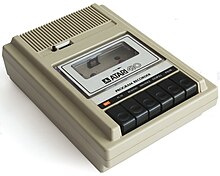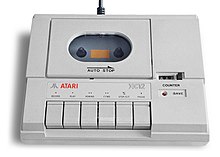This article possibly contains original research. (April 2023) |




The Atari Program Recorder is Atari's dedicated magnetic-tape data storage device for the Atari 8-bit computers. The original 410 was launched along with the Atari 400 and 800 machines in 1979. The 1010 was a smaller model introduced to match the styling of the XL series released in 1983. XC12 of 1986 matched the XE series and was sold mostly in eastern Europe and South America. Slight variations of all of these models were also introduced from time to time.
The data rate was nominally 600 bit/s, but the simple error correction and short gaps between the resulting packets lowered this somewhat. In the end, its rate was roughly double that of the formats used by the Commodore Datasette or the TI-99/4. In some markets, where the Program Recorder was the only cost-effective storage solution, software-based high-performance modes were developed that operated more than three times as fast, and as much as four times as fast with simple hardware modifications.
The drives had several features not commonly found on other platforms. The system's device driver supported a packet-based format with checksums for error detection, as opposed to lacking any error detection or using whole-file checksums. The driver included separate formats for binary data and more complex data that required longer to process it. The left audio channel could be used to send audio through to the television speaker, which could be used to provide music during the loading period, or in program-controlled computer aided instruction systems.
© MMXXIII Rich X Search. We shall prevail. All rights reserved. Rich X Search
